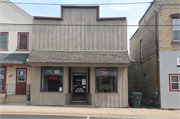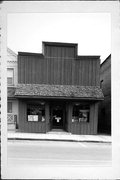Property Record
115 N 4TH ST
Architecture and History Inventory
| Historic Name: | Emil Gaebler Music Store and Organ Shop |
|---|---|
| Other Name: | The Travel Bug |
| Contributing: | No |
| Reference Number: | 74726 |
| Location (Address): | 115 N 4TH ST |
|---|---|
| County: | Jefferson |
| City: | Watertown |
| Township/Village: | |
| Unincorporated Community: | |
| Town: | |
| Range: | |
| Direction: | |
| Section: | |
| Quarter Section: | |
| Quarter/Quarter Section: |
| Year Built: | 1867 |
|---|---|
| Additions: | |
| Survey Date: | 19862020 |
| Historic Use: | small retail building |
| Architectural Style: | Commercial Vernacular |
| Structural System: | |
| Wall Material: | Brick |
| Architect: | |
| Other Buildings On Site: | |
| Demolished?: | No |
| Demolished Date: |
| National/State Register Listing Name: | Main Street Commercial Historic District |
|---|---|
| National Register Listing Date: | 6/2/1989 |
| National Register Multiple Property Name: |
| Additional Information: | This building was the location, between c. 1867 and c. 1883 of the Emil Gaebler Music Store. Emil Gaebler was a German immigrant who helped found the Concordia Society, a musical performing society, in Watertown in 1862. He was the early director of this society. Later, this building housed several other retail businesses. This building might be significant under National Register criteria A and B. It was the location of the store of Emil Gaebler, an important early merchant who helped found the Concordia Society. The Concordia Society was the most significant German singing and performing group founded in Watertown. Many of the Germans in Watertown were educated and familiar with the arts. They established a number of German ethnic institutions that reflected this interest. The Concordia Society was a popular organization and provided high-quality entertainment to the public. Because Emil Gaebler founded the organization that was the leading music society in the community, his music store, probably integrally involved in the society, is significant. However, the building has lost considerable integrity, and little reflects its historic apppearance. Therefore, this building questionably meets the criteria. Gaebler's home, next door, has better integrity, and may be a better representative of his life and work than this store. Built by Emil Gaebler, a manufacturer of pipe organs around 1867-68, this small three-bay commercial building presently exhibits a facade covered by vertical wood siding and cream brick rear and side walls. The building has a storefront featuring a pent roof and recessed entrance. Originally the Gaebler building had a cream brick facade topped by a rectangular brick pediment. A one story addition is at the rear. Although historically significant as the site of Emil Gaebler's Music Store and Craftshop, this building has lost considerable architectural integrity. As a result, the Gaebler building does not contribute to the historic character of the Main Street Historic District. |
|---|---|
| Bibliographic References: | (A) Tax Records, City of Watertown, 1860-1910, Area Research Center, Library, University of Wisconsin-Whitewater. (B) Sanborn Insurance Map, City of Watertown, 1884. (C) "Revised Tariff Rates for Watertown, Wis.," National Board of Fire Underwriters, April 13, 1876. (D) Photograph: Folio, City of Watertown, 1887, Archives, Octagon House, Watertown Historical Society. (E) Tax Rolls, City of Watertown, Area Research Center, University of Wisconsin-Whitewater Library. (F) "German Settlers Brought Love of Music With Them When They Settled in Area," Watertown Daily Times Centennial Issue, June 26, 1954, n.p. |
| Wisconsin Architecture and History Inventory, State Historic Preservation Office, Wisconsin Historical Society, Madison, Wisconsin |


